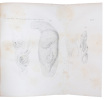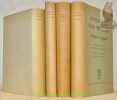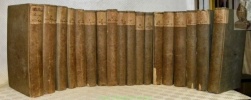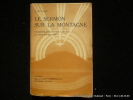46 books for « muller johannes »Edit
-
Century
18th (4)
19th (8)
20th (12)
-
Countries
Belgium (4)
Denmark (3)
France (16)
Switzerland (23)
-
Syndicate
ILAB (28)
NVVA (11)
SLACES (11)
SLAM (7)
Topics
- Arabic (1)
- Archaeology (1)
- Aristotle (1)
- Biography (1)
- Biology (1)
- Christianity (1)
- Discovery (1)
- Engravings (3)
- Europe (2)
- Fine arts (1)
- Greece (1)
- Helvética (18)
- History (8)
- Humanity (1)
- Iconography (2)
- Industrial arts & crafts - fine arts (3)
- Islam muslim (1)
- Law (1)
- Legends (1)
- Literature (1)
- Mountain (1)
- Orientalism (1)
- Painting (3)
- Philosophy (2)
- Religions (1)
- Russia (1)
- Switzerland (20)
- Tea (1)
- Writing - calligraphy (2)
- Zoology (1)
- Zurich (1)
"MÜLLER, JOHANNES & THEODOR SCHWANN. - THE DISCOVERY OF PEPSIN, THE FIRST KNOWN ANIMAL ENZYME & THE ""FIBRES OF REMAK""
Reference : 45406
(1836)
Versuche über die künstliche Verdauung des geronnenen Eiweisses (Müller & Schwann) (+) Ueber das Wesen des Verdauungsprocesses (Schwann). 2 paers.
Berlin, G. Eichler, 1836. In ""Archiv für Anatomie, Physiologie und Wissenschaftliches Medicin Herausgegeben von Johannes Müller"". Jahrgang 1836. Pp. 66-89 a. pp. 90-139. The entire volume offered in its 6 parts (in 5), all 5 issues uncut with orig. printed warppers. (2),CCXXIV,390 pp. and 15 engraved plates. The 2 first issues with a faint dampstain to lower part of leaves and plates.
First appearance of an importent paper in the history of biology, in which Schwann describes his discovery and isolation of pepsin, the substance in the stomach that aids digestion of eggwhite. It is the FIRST KNOWN ANIMAL ENZYME. The paper appeared at the same time in ""Annalen der Physik und Chemie. Hrsg. von J.C. Poggendorff"".Theodor Schwann (1810-1882) was a great German physiologist, pathologist, and experimenter. One of the founders of the cell doctrine and of the idea of the living nature of yeast. Born at Neuss, near Düsseldorff. A catholic, educated in the Jesuit Gymnasium in Cologne. Intended for the church but took to medicine. He was a pupil of Johannes Müller and a collegueand lifelong friend of J. Henle, the anatomist. In Berlin Schwann was Johannes Müller's assistent for five years, and it was then that he discovered pepsin in 1836 (the paper offered).Parkinson ""Breakthroughs"" 1836 B. - Garrison & Morton no. 991.The first paper offered, written together with Johannes Müller records the preliminary investigaions leading to the discovery of Pepsin. - Garrison & Morton no. 990.The volume also contains another famous paper by ROBERT REMAK ""Vorläufige Mittheilung microscopischer Beobachtungen über den innern Bau der Cerebrospinalnerven und über die Entwicklung ihrer Formenelemente. (Hierzu Tafel IV). Pp. 145-161. This paper contains the first announcement of his DISCOVERY OF ""FIBRES OF REMAK"", the non-medullated nerve-fibres. (Garrison & Morton no. 1260.
Über den glatten Hai des Aristoteles, und über die Verschiedenheiten unter den Haifischen un Rochen in der Entwickelung des Eies. [In: Abhandlungen der Königlichen Akademie der Wissenschaften zu Berlin. Aus dem Jahr 1840]. - [ESTABLISHING ARISTOTLE AS THE FOUNDER OF BIOLOGICAL SCIENCE]
Berlin, 1842. 4to. Entire volume of ""Abhandlungen""... and ""Mathamatische Abhandlungen""... 1840 present. Contemporary yellow boards with a vellum-like spine. Handwritten title to spine. A bit of wear and soiling to extremities, and corners bent. Internally fine and clean. Stamp to title-page (Dom-Gymnasium Magdeburg, also stamped out). Pp. (187)- 257 + 6 plates, two of which are folded. Text very nice, bright, and clean, plates with a bit of brownspotting. [Entire volume: (6), XVII, (5), 400 pp. + 10 plates, 4 of which are coloured + (4), 137 pp.].
First printing of this foundational work, which established the acceptance, by the modern world, of Aristotle as the founder of biological science. It is due to the present work that modern encyclopaedias will now conclude that ""Aristotle is properly recognized as the originator of the scientific study of life."" (SEP). Apart from its importance to the modern view of Aristotle, the present paper was also central to Müller's construction of a natural system of the fishes. For centuries, the authority of Aristotle in matters of science and biology was unrivalled, but with modern science, the advancement of exact knowledge, and modern man's ability to investigate the smallest of details, Aristotle's scientific and zoological works increasingly came to be viewed as not properly belonging to the exact sciences. Many biologists would claim that his observations were fanciful and incorrect, not constituting any real scientific value. This view completely changed with the publication of the present paper, by the renowned zoologist Müller.In his ""Historia Animalium"", Aristotle had described a phenomenon in a shark, which no modern zoologist believed to be true. Had it been true, our classification among sharks and fish would need to be different, as this fanciful observation would completely alter our view of the shark as such. Müller, in the present treatise, was the first to actually prove Aristotle's observation to be true, thereby altering the modern conception of Aristotle, earning him the respect that he truly deserved as the first scientific biologist and as the originator of the scientific study of life. ""Müller placed the Cyclostomata among the fishes. He was thus led to study the sharks... A further product of this investigation was ""Über den glatten Hai des Aristoteles"" (1842). In ""Historia animalium"", Aristotle had reported that the embryos of the ""so-called smooth shark"" are attached to the uterus of the mother by a placenta, as is the case among mammals. Rondelet had described such a shark in 1555 and Steno had observed one in 1673 off the coast of Tuscany, but it had not been referred to in more recent times. Müller was the first who was able to corroborate the earlier testimony.In conjunction with the study of the shark, Müller constructed a natural system of the fishes based on work as painstaking as it was perceptive."" (DSB).Johannes Peter Müller (1801-58) was one of the most important physiologists and zoologists of the 19th century. He made a vast number of important discoveries, and his unusual and empirical approach to his subjects made him one of the most influential scientists of the century. ""Müller introduced a new era of biological research in Germany and pioneered the use of experimental methods in medicine. He overcame the inclination to natural-philosophical speculation widespread in German universities during his youth, and inculcated respect for careful observation and physiological experimentation. He required of empirical research that it be carried out ""with seriousness of purpose and thoughtfulness, with incorruptible love of truth and perseverance."" Anatomy and physiology, pathological anatomy and histology, embryology and zoology-in all these fields he made numerous fundamental discoveries. Almost all German scientists who achieved fame after the middle of the nineteenth century considered themselves his students or adopted his methods or views. Their remarks reveal his preeminent position in medical and biological research. Helmholtz, one of his most brilliant students, termed Müller a ""man of the first rank"" and stated that his acquaintance with him had ""definitively altered his intellectual standards""."" (DSB).
Grund-Riss der Stadt Zürich mit Innbegriff dess um die Stadt und derselben Vestungs-Werke liegenden Stadt-Banns, oder dess Ganzen Bezirks der Stadt bis an die sogenannten Kreuz-Marken. Im genauesten Detail ausgemessen und gezeichnet 1788 bis 1793 von Johannes Müller.
Zürich, E. Matthieu, (1974). Faksimile aufgezogen auf Leinwand. Bildformat: 156 x 200 cm.
Johannes Müller (1733-1816) war Ingenieur, Mathematiker und Kalendermacher. Er zeichnete den Plan zwischen 1788 und 1793 auf 20 Blätter und verfasste dazu ein Verzeichnis der Bürger mit Berufsangabe. - Ohne das Begleitheft. in sehr gutem Zustand. In Orginalverpackung (Rolle).
Merckwürdige Überbleibsel von Alter-Thümeren an verschiedenen Orthen der Eijdtgenosschaft. Nach Originalien gezeichnet und in Kupfer heraus gegeben von / durch Johannes Müller. Ingenieur zu Zürich. 1ter bis 12ter Theil. in 3 Bde gebunden.
Zürich, Selbstverlag, 1773-1783, in-8vo, 12 Teile in 3 Bänden, 228 S. + 276 Kupfertafeln (davon 12 Titelblätter und viele Falttafeln), insgesamt nur leicht stockfleckig, gest. Exlibris von: G:E a Wagner. Braune Halblederbde der Zeit mit kleinen Ecken und gesprenkeltem Bezugspapier (sog. Kiebitzpapier). Rücken mit Bandnummern u. Rückenschildchen.
Komplette Folge der sehr seltenen, kaum auffindbaren ersten Kunsttopographie der Schweiz, mit wertvollem topographischem und archäologischem Bildmaterial: Ansichten, Fundgegenstände aller Art, Münzen, Denkmäler, Portraits, historische Ereignissen aus der Schweiz, usw. / 1 Falttafel „Jährlicher Umzug des äussern Stands, Loblichn. Canton Bern“ in Theil 12, prächtig koloriert, sowie eine Tafel teilkoloriert. - Johannes Müller war Ingenieur, Mathematiker, Kartograf u. Kunstverleger. Das bedeutendste Werk seines Verlags erschien in 12 Lieferungen und liegt hier komplett vor. Band 1, I) 32 S. + 24 Kupfer / II) 28 S. + 24 Kupfer / III) 22 S. + 21 Kupfer (davon 2 Falttaf.) / 1 Bl. weiss / IV) 10 S. + 26 Kupfer (davon 4 Falttaf.). (99 Kupfer, Titelbl. inkl.)Band 2, V) 18 S. + 21 Kupfer (davon 2 Falttaf.) / VI) 27 S (+ 1 weiss) + 22 Kupfer / VII) 16 S. + 20 Kupfertaf. (davon 2 Falttaf., 1 alt restauriert) / VIII) 16 S. + 21 Kupfer (davon 5 Falttaf.) (88 Kupfer. Titelbl. inkl.)Band 3, IX) 10 S. + 6 S. (= Römische Alterthümer dazu 3 Tafeln) + 2 Bl. weiss + 25 Kupfer (3 Falttaf.) / X) 16 S. + 17 Kupfer (Titelbl. inkl.) (davon 4 Falttaf.) / XI) 10 S. + 22 Kupfer (davon 1 Falttaf.) / XII) 10 S. + 22 Kupfer (1 Falttafel prächtig koloriert + 1 Tafel teilkoloriert) + 7 S. Register. (89 Kupfer. Titelbl. inkl.)Insgesamt 264 Kupfertafeln + 12 Kupfertitel (= 276 Tafeln).Heft X, Titelbl. (= Abb. I) + 16 S. + Abb. II-XVII, alle 17 Tafeln (davon 5 Falttafeln) vorhanden (diese scheinen oft zu fehlen). Haller IV, 5 & 195; Barth 26335; Lonchamp 2157; Leemann-van Elck: Zürcher Buchillustr., S. 165. Image disp.

(SLACES, NVVA)
Phone number : 41 (0)26 3223808
Konvolut von 2 Büchern. 1) STOKAR, Willy: Johannes Von Müller. 1938, 239 S., OU /2) MÜLLER, Johannes: Bilder und Gestalten aus der älteren Schweizergeschichte. Mit 12 kolorierten Zeichnungen von Fritz Buchser. 205 S. + 12 Farbtafeln.
in-8vo, Original-Leinenbände.

(SLACES, NVVA)
Phone number : 41 (0)26 3223808
Physiologie du système nerveux ou recherches et expériences sur les diverses classes d'appareils nerveux, les mouvemens, la voix, la parole, les sens, et les facultés intellectuelles
Paris, J.-B. Baillière, 1840, in-8, 2 vol, VI-640 + [4]-644 pp, 4pl, Demi-percaline fauve à la bradel, pièces de titre et de tomaison noires, Première édition française, traduite de l'allemand, sur la troisième édition. Cet ouvrage forme la partie la plus considérable du fameux traité de Physiologie de Müller (Handbuch der Physiologie des Menschen für Vorlesungen, Coblenz, Hölscher, 1834-40). Il a été ajouté au chapitre de la voix humaine, la version d'un opuscule que M. Müller venait alors de publier séparément, sur la compensation des forces physiques dans l'organe de l'homme (Ueber die Compensation der physischen Kroefte am menschlichen Stimmorgen, Berlin, 1839, avec 4 planches). Le physiologiste allemand Johannes Peter Müller (1874-1955) considéré généralement comme le père de la physiologie moderne, établit ici que la perception se produit par des organes sensoriels recevant des stimuli. Il fait partie des physiologistes qui, à partir de l'étude des sensations, sont à l'origine de la psychophysique dont procède la psychologie expérimentale. Tampon annulé de l'Institut catholique de Paris et étiquette de don de la bibliothèque des Liouville. Bel exemplaire, malgré quelques rousseurs, de cet ouvrage rare. Étiquettes en pied des dos. Dos brunis, une coiffe supérieure arasée. Couverture rigide
Bon 2 vol., VI-640 + [4]-644 pp.,
Johannes Müllers Räthe an die Eidsgenossenschaft. Gesammelt und mit einigen zuästzen begleiten von einem Freunde seines Vaterlandes (i.e. Johann Wilhelm Veith). - angebunden: Noch einige Räthe an die Eidgenossen. Aus ungedruckten Papieren desselben.
(S.l., s.n., März und Mai 1814. 32, 15 S. Späterer Broschurumschlag.
Barth 5377 und 5378. - Vom Schaffhauser Pfarrer Veith (1758-1833) herausgegebene Flugschrift mit Textstellen aus unveröffentlichten Werken von Johannes von Müller. - Stellenweise fleckig.
[Histoire de la Confédération Suisse] Der Geschichten schweizerischer Eidgenossenschaft.
1786 Leipzig, M. B. Weidmanns Erben und Reich, 1786.
2 volumes (sur 5) in-8 (20,8 x 12 cm), veau blond (reliure de l’époque), dos lisse à riche décor aux petits fers, chiffre en pied (J. G. C.), pièces de titre de maroquin rouge et de tomaison vert, triple filet doré encadrant les plats, roulette doré sur les coupes, texte en allemand en caractères gothiques. xl-614-[2] ; [12]-740-[2] pages. Manque les 3 derniers volumes. Couvrure frottée, coiffes accidentées, coins émoussés, rousseurs éparses. État correct. ÉDITION ORIGINALE de cette histoire de la Suisse, parue de 1786 à 1808, véritable grand œuvre de son auteur. Johannes von Müller (1752-1809) est un historien suisse. Après des études de théologie et parallèlement à divers emplois de bibliothécaire, pour le prince-évêque de Mayence ou l’empereur d’Autriche François Ier, Müller publie son unique grande œuvre : l’Histoire de la Suisse. En 1806, après avoir rencontré Napoléon, il est nommé secrétaire d’État pour le royaume de Westphalie. Son Histoire universelle fut publiée après sa mort par son frère. Bon exemplaire.
Johannes von Müller.
(Orell Füssli Zürich), 1882, Blatt 23x32.5 cm. Porträt + 4 S. mit biographischem Text von Alfr. Hartmann. O.-Lithographie aus ‘Gallerie berühmter Schweizer der Neuzeit’.

(SLACES, NVVA)
Phone number : 41 (0)26 3223808
Portrait. v. Johannes von Müller.
Baden im Aargau, Hasler, 1868, Blatt 23x32.5 cm. Porträt + 4 S. mit biographischem Text von Alfr. Hartmann. 1 Blatt.
O.-Lithographie aus ‘Gallerie berühmter Schweizer der Neuzeit’.

(SLACES, NVVA)
Phone number : 41 (0)26 3223808
Zum zweihundertsten Geburtstag des Geschichtschreibers Johannes von Müller 1752-1952. Schaffhauser Beiträge zur vaterländischer Geschichte 29. Heft.
Thayngen, Karl Augustin Druck u. Verlag, 1952, gr. in-8vo, 221 S. + 18 Tafeln (11 Aufsätze versch. Autoren mit Portr. und Bibliographie), Original-Pappband.

(SLACES, NVVA)
Phone number : 41 (0)26 3223808
Schriften in Auswahl. Briefe in Auswah. Zweite, druchgesehene und erweiterte Auflage.Studien zu Johannes von Müller von Edgar Bonjour. Briefwechsel mit Johann Gottfried Herder und Caroline v. Herder geb. Flachsland 1782-1808. Hrsg. von K. E. Hoffmann. 4 Bände.
Basel - Schaffhausen, Benno Schwabe- Meier 1955, 225x155mm, 210x130mm, Verlegereinband mit Umschlag. Sehr schönes Exemplar.
Pour un paiement via PayPal, veuillez nous en faire la demande et nous vous enverrons une facture PayPal
Johannes von Müller. Portrait.Lithographie aus: Alfr. Hartmann: Gallerie berühmter Schweizer der Neuzeit.
1871, Blatt 23x32.5 cm. Leicht stockfleckig. + 4 S. Text. 1 Blatt.
Image disp.

(SLACES, NVVA)
Phone number : 41 (0)26 3223808
Die Geschichten der Schweizer.
Erster Band (alles Erschienene). Boston (i. e. Bern), bey der neuen typographischen Gesellschaft, 1780. 8°. XLVI S., (1) Bl., 444, (4) S. Halblederband mit schlichter Rückenvergoldung und Rückenschild.
Feller/Bonjour 551. – Der erste Druck von Johannes Müllers (1752–1809) Jugendwerk, wobei ihn sein langjähriger Freund Karl Viktor von Bonstetten (1745–1832) unterstützte die Geschichte der Schweiz von den Anfängen bis 1388 zu publizieren. «Müller verarbeitete darin ein gewaltiges Material, wie es noch kein Historiker zusammengetragen hatte, Chroniken und Urkunden» (Feller/Bonjour). – Papier zum Teil wasserrandig. Die Vorsätze leimschattig. Mit altem handschr. Besitzereintrag. Der Einband berieben und bestossen.
Miniatures arabes. Introduction, choix et textes de présentation des miniatures par Johannès Müller.
P., Siloé, 1979, grand in 4° relié pleine toile de l'éditeur, jaquette illustrée (avec petits défauts d'usage).
Texte et 50 planches en couleurs. ...................... Photos sur demande ..........................


Phone number : 04 77 32 63 69
Johannes von Müller. Aus den Geschichten Schweizerischer Eidgenossenschaft. Mit einem Geleitwort von Dr. Rolf Henne.
Zürich, Verlag Volk und Schriftum 1940, 210x135mm, 95Seiten, broschiert.
Pour un paiement via PayPal, veuillez nous en faire la demande et nous vous enverrons une facture PayPal
Miniatures arabes.
Paris, Editions Siloé, 1979. 28 x 34, sans pagination, 50 planches en couleurs, reliure d'édition pleine toile + jaquette, bon état (jaquette légèrement défraîchie).
introduction, choix et textes de présentation des miniatures par Paul Johannes Müller.
Briefwechsel und Familienbriefe 1766-1789. 6 Bände im Schuber.Band I : Briefe 1766-1779. Band II : Briefe 1779-1783. Band III : Briefe 1783-1789. Band IV: Erläuterungen Briefe 1-309. Band V: Erläuterungen Briefe 310-643. Band VI:Nachwort. Editorischer Bericht. Verzeichnisse Register.Herausgegeben von André Weibel.
Göttingen, Wallstein 2009-2011, 235x140mm, Verlegereinband mit Umschlag. Exemplar wie neu.
s/w Figuren im Text, Pour un paiement via PayPal, veuillez nous en faire la demande et nous vous enverrons une facture PayPal
Briefe eines jungen Gelehrten an seinen Freund. Zum Besten der Schweizerwaisen herausgegeben (von Frederike Brun).
Tübingen, in der J.C. Cotta'schen Buchhandlung. 1802. 8°. VI S., 406 S., 1 Bl. Anzeigen. Halblederband der Zeit mit hellrotem goldgeprägtem Rückenschild und wenig Rückenvergoldung.
Goedeke VI, 289,alpha. - Erste Buchausgabe. - Von Frederike Brun herausgegebene Sammlung von 149 Briefen an Karl Viktor von Bonstetten aus den Jahren 1773 bis 1779. - Mit handschriftlichem Besitzvermerk von Johann Ludwig Peyer, Schaffhausen. Peyer (1722-1813) war Politiker in Schaffhausen. Unter der österreichischen Besetzung Schaffhausens wurde er 1799-1800 Amtsbürgermeister der Interimsregierung. Er stand mit Müller im Briefkontakt. - Deckel beschabt. Durchgängig mässig stockfleckig. Vorsätze mit Leimschatten.
Vier und Zwanzig Bücher Allgemeine Geschichten besonders der Europäischen Menschheit. Hrsg.v. Johann Georg Müller. 3. Aufl. 3 Bde.
Tübingen, 1817. 3 orig.boards. 540,552,532 pp.
Vier und zwanzig Bücher Allgemeiner Geschichten besonders der Europäischen Menschheit. Herausgegeben nach des Verfassers Tode durch dessen Bruder Johann Georg Müller.
24 Teile in 3 Bänden. Upsala, Bruzelius, 1812. 8°. Halblederbände der Zeit (berieben und bestossen).
Sämmtliche Werke. Herausgegeben nach des Verfassers Tode durch dessen Bruder Johann Georg Müller. 18 Bände, (1 - 18).
Tübingen, J.C. Cotta’schen Buchhandlung 1810-1814, 215x130mm, Pappband.
Pour un paiement via PayPal, veuillez nous en faire la demande et nous vous enverrons une facture PayPal
Le Sermon sur la Montagne. Tranposé dans notre langage et pour notre temps. 3e éd.
Paris, Delachaux & Niestlé, 1929, in-8, Broché, 326 pages. Bon état
NB Le délai d'acheminement vers la France est de 48h.
Der Geschichten schweizerischer Eidgenossenschaft.
12 (von 18) Teilen in 7 Bänden. Frankenthal, Gegel, 1790-1807. 8°. Pappbände der Zeit mit braunem gestreiftem Papierbezug und Rückenschildern.
Papier durchgehend leicht gebräunt und stockfleckig. Einbände berieben.
Iets over brandstichting
Leiden, A.H. Adriani 1882 71pp., 23cm., linnen band met titel in goudopdruk (licht bevlekt), alle bladsneden verguld, Doctoraal proefschrift ((Rijks-Universiteit te Leiden), stempeltje op achterzijde titelblad, tekst is helder en in goede staat, J112073
 Write to the booksellers
Write to the booksellers


![[Histoire de la Confédération Suisse] Der Geschichten schweizerischer Eidgenossenschaft.. MÜLLER (Johannes von)](https://static.livre-rare-book.com/pictures/NGZ/50_1_thumb.jpg)
![[Histoire de la Confédération Suisse] Der Geschichten schweizerischer Eidgenossenschaft.. MÜLLER (Johannes von)](https://static.livre-rare-book.com/pictures/NGZ/50_2_thumb.jpg)
![[Histoire de la Confédération Suisse] Der Geschichten schweizerischer Eidgenossenschaft.. MÜLLER (Johannes von)](https://static.livre-rare-book.com/pictures/NGZ/50_3_thumb.jpg)









